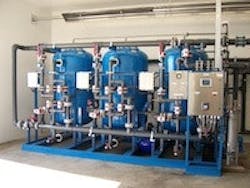Reducing Contaminants in Canadian Resort Village
In November 2009, AdEdge Water Technologies LLC was selected, among other vendors in a tender, by the Resort Village of Kannata Valley (RVKV) to supply an arsenic, iron, manganese and turbidity treatment system for their community in Silton, Saskatchewan. Prior to selection, AdEdge worked with its local representative, The Water Clinic, on piloting the system that was chosen.
The water system currently uses one 132-gal-per-minute (gpm) artesian well that provides potable water to 260 connections. Several options were considered based on the need to remove the 1.7 to 2.14 mg/L iron and arsenic concentration from 31 ppb to below the new maximum contaminant level (MCL) of 10 ppb.
An AdEdge AD26 oxidation/filtration system was selected as the best overall approach to simultaneously remove both contaminants while having a small footprint. Work was closely coordinated with the RVKV and its consultant to design and permit the treatment system.
Following the award, all appropriate permitting documents were prepared and submitted to the province for approval. The permit was granted in January 2010.
The AdEdge scope of work included system design, supply and start-up assistance. The packaged AD26 system utilizes an NSF 61 certified manganese dioxide media (AD26) that is ideal for co-contaminant removal. The technology was selected based on its overall cost, small footprint and simplicity of operation.
The AdEdge AD26 arsenic treatment train consists of one skid mounted triplex packaged treatment systems with three vessels in parallel to treat up to 150 gpm. A design filtration rate of 3.98 gpm/sq ft was chosen to allow for filtration of the high level of contaminants including turbidity in a range of 6.34 to 12.0 NTU.
The AD26 automated system—equipped with a programmable logic controller (PLC), automated butterfly valves and control panel—is integrated with chlorine addition and monitoring for process control and disinfection purposes. The system also includes air wash and complete backwash recycle, providing a treatment system with zero discharge. The system is pre-engineered, pre-piped and skid mounted for ease of installation and operation. A continuous free chlorine monitor on the system allows the operator to maintain desired disinfection residual in the distribution system. The AD26 technology has been deployed successfully by AdEdge on many high arsenic, iron, and manganese wells to date and also on five full-scale U.S. Environmental Protection Agency (EPA) arsenic demonstration projects
Installation was completed and the system was officially started up in August 2010. Since operations began, the system has consistently met the EPA MCLs for arsenic, iron and manganese. Arsenic in the treated water has been recorded consistently below detection (less than 2 ppb) and Turbidity to 0.014 NTU. Monitoring and periodic sampling of the system is performed by the site’s certified operator in accordance with the operating permit.
Richard J. Cavagnaro is marketing coordinator for AdEdge. Cavagnaro can be reached at [email protected] or 678.835.0052.
